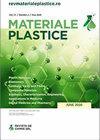Synthesis and Characterization of Novel Nano Six-arms of (polylactide-dipentaerythritol)-block-N-hydroxyethyl Acrylamide and N,N-dimethylamino Ethyl Methacrylate Biocopolymers by Atom Transfer Radical Polymerization
IF 0.6
4区 材料科学
Q4 MATERIALS SCIENCE, MULTIDISCIPLINARY
引用次数: 0
Abstract
Novel block biocopolymers were made by copolymerizing the prepared polylactide-dipenta-erythritol macromonomer with two different monomers, N-hydroxyethyl acrylamide (HEAA) and N,N-dimethylamino ethyl methacrylate (DMAEMA), with an activator generated by atom transfer radical polymerization (ATRP), to have a different duplicating unit of 10, 25, 50, and 100. ATRP employs a copper(I) bromide (CuBr) catalyst system with N, N, N′, N′′, N′′-pentamethyl diethylenetriamine (PMDETA). Different spectroscopic and analytical methods used for characterization of the prepared biocopolymers, such as FT-IR, 1H NMR, 13C NMR, and GPC, showed that they had narrow dispersity with controllable molecular weight and were accompanied by nanostructures as examined by SEM technique on all biocopolymers, confirming the correctness of the expected structures of biocopolymers. The shape and size of the produced polymeric nanoparticles were determined using a scanning electron microscope (SEM), and they were developed using the Image-J application.原子转移自由基聚合合成新型(聚乳酸-二季戊四醇)-嵌段-N-羟乙基丙烯酰胺和N,N-二甲基氨基乙基甲基丙烯酸酯纳米六臂生物聚合物及其表征
用原子转移自由基聚合(ATRP)产生的活化剂,将制备的聚乳酸-二五红四醇大单体与N-羟乙基丙烯酰胺(HEAA)和N,N-二甲氨基甲基丙烯酸乙酯(DMAEMA)进行共聚,得到了复制单元分别为10、25、50和100的新型嵌段生物共聚物。ATRP采用一种溴化铜(cur)催化剂体系,含有N, N, N ', N ', N ' -五甲基二乙烯三胺(PMDETA)。利用FT-IR、1H NMR、13C NMR和GPC等不同的光谱和分析方法对所制备的生物聚合物进行表征,结果表明,所制备的生物聚合物具有较窄的分散性,分子量可控,并且在所有生物聚合物上都伴有纳米结构,证实了所制备的生物聚合物结构的正确性。通过扫描电子显微镜(SEM)确定了聚合物纳米颗粒的形状和大小,并使用Image-J应用程序对其进行了开发。
本文章由计算机程序翻译,如有差异,请以英文原文为准。
求助全文
约1分钟内获得全文
求助全文
来源期刊

Materiale Plastice
MATERIALS SCIENCE, MULTIDISCIPLINARY-
CiteScore
1.40
自引率
25.00%
发文量
99
审稿时长
6-12 weeks
期刊介绍:
Materiale Plastice, abbreviated as Mater. Plast., publishes original scientific papers or guest reviews on topics of great interest.
The Journal does not publish memos, technical reports or non-original papers (that are a compiling of literature data) or papers that have been already published in other national or foreign Journal.
 求助内容:
求助内容: 应助结果提醒方式:
应助结果提醒方式:


